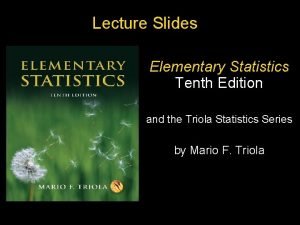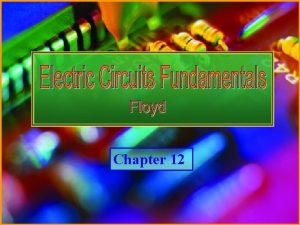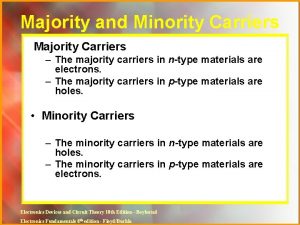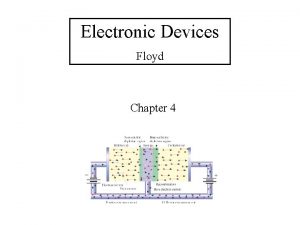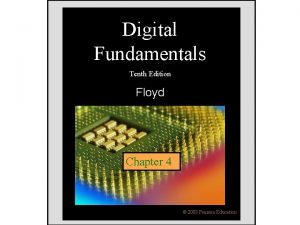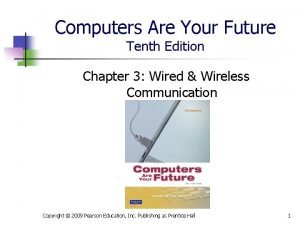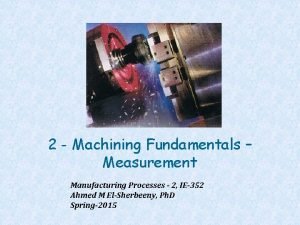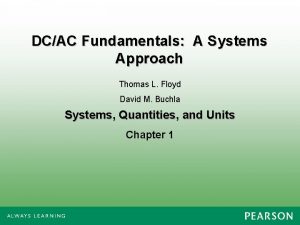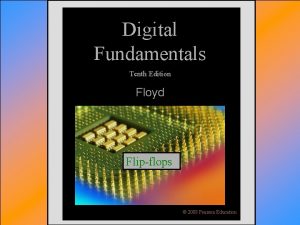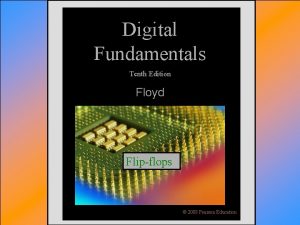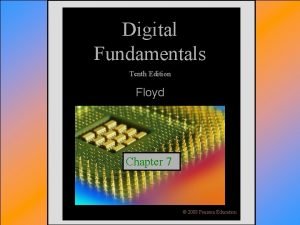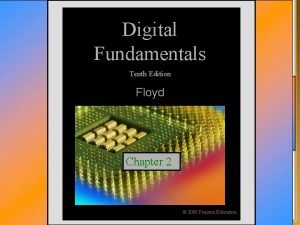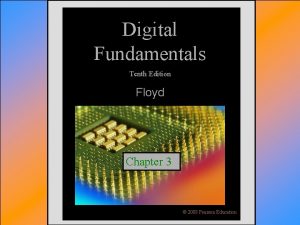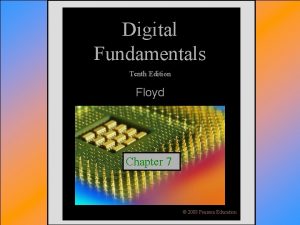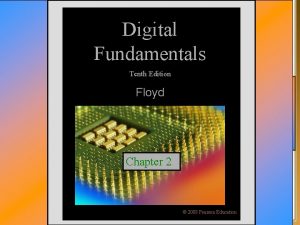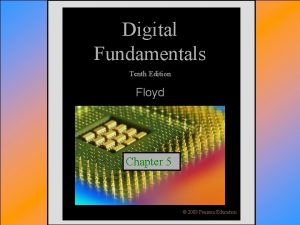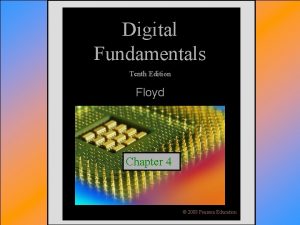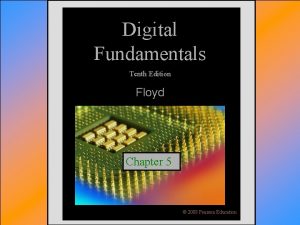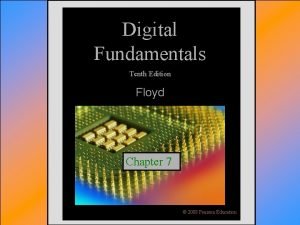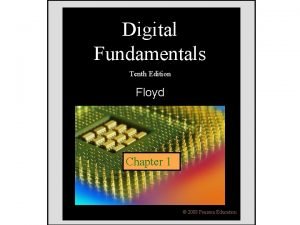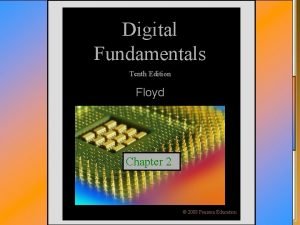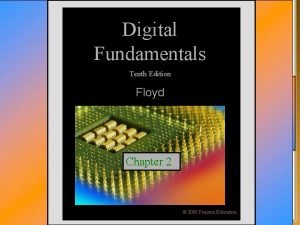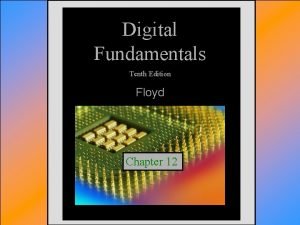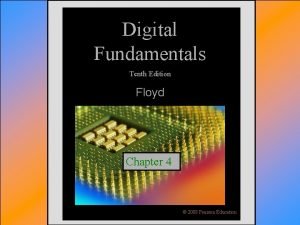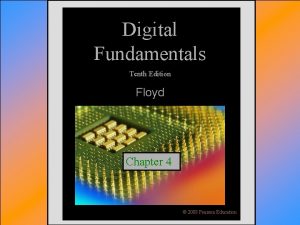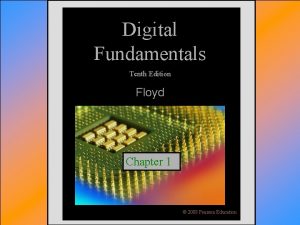Digital Fundamentals Tenth Edition Floyd Chapter 2 Floyd


































- Slides: 34

Digital Fundamentals Tenth Edition Floyd Chapter 2 Floyd, Digital Fundamentals, 10 th ed 2008 Pearson Education © 2009 Pearson Education, ©Upper Saddle River, NJ 07458. All Rights Reserved

Summary Decimal Numbers The position of each digit in a weighted number system is assigned a weight based on the base or radix of the system. The radix of decimal numbers is ten, because only ten symbols (0 through 9) are used to represent any number. The column weights of decimal numbers are powers of ten that increase from right to left beginning with 100 =1: … 105 104 103 102 101 100. For fractional decimal numbers, the column weights are negative powers of ten that decrease from left to right: 102 101 100. 10 -1 10 -2 10 -3 10 -4 … Floyd, Digital Fundamentals, 10 th ed © 2009 Pearson Education, Upper Saddle River, NJ 07458. All Rights Reserved

Summary Decimal Numbers Decimal numbers can be expressed as the sum of the products of each digit times the column value for that digit. Thus, the number 9240 can be expressed as (9 x 103) + (2 x 102) + (4 x 101) + (0 x 100) or 9 x 1, 000 + 2 x 100 + 4 x 10 + 0 x 1 Express the number 480. 52 as the sum of values of each digit. 480. 52 = (4 x 102) + (8 x 101) + (0 x 100) + (5 x 10 -1) +(2 x 10 -2) Floyd, Digital Fundamentals, 10 th ed © 2009 Pearson Education, Upper Saddle River, NJ 07458. All Rights Reserved

Summary Binary Numbers For digital systems, the binary number system is used. Binary has a radix of two and uses the digits 0 and 1 to represent quantities. The column weights of binary numbers are powers of two that increase from right to left beginning with 20 =1: … 25 24 23 22 21 20. For fractional binary numbers, the column weights are negative powers of two that decrease from left to right: 22 21 20. 2 -1 2 -2 2 -3 2 -4 … Floyd, Digital Fundamentals, 10 th ed © 2009 Pearson Education, Upper Saddle River, NJ 07458. All Rights Reserved

Summary Binary Numbers A binary counting sequence for numbers from zero to fifteen is shown. Notice the pattern of zeros and ones in each column. Digital counters frequently have this same pattern of digits: Floyd, Digital Fundamentals, 10 th ed Decimal Number Binary Number 0 1 2 3 4 5 6 7 8 9 10 11 12 13 14 15 0000 0001 0010 0011 0100 0101 0110 0111 1000 1001 1010 1011 1100 1101 1110 1111 © 2009 Pearson Education, Upper Saddle River, NJ 07458. All Rights Reserved

Summary Binary Conversions The decimal equivalent of a binary number can be determined by adding the column values of all of the bits that are 1 and discarding all of the bits that are 0. Convert the binary number 100101. 01 to decimal. Start by writing the column weights; then add the weights that correspond to each 1 in the number. 25 24 23 22 21 20. 2 -1 2 -2 32 16 8 4 2 1. ½ ¼ 1 0 0 1 32 +4 +1 +¼ = 37¼ Floyd, Digital Fundamentals, 10 th ed © 2009 Pearson Education, Upper Saddle River, NJ 07458. All Rights Reserved

Summary Binary Conversions You can convert a decimal whole number to binary by reversing the procedure. Write the decimal weight of each column and place 1’s in the columns that sum to the decimal number. Convert the decimal number 49 to binary. The column weights double in each position to the right. Write down column weights until the last number is larger than the one you want to convert. 26 25 24 23 22 21 20. 64 32 16 8 4 2 1. 0 1 1 0 0 0 1. Floyd, Digital Fundamentals, 10 th ed © 2009 Pearson Education, Upper Saddle River, NJ 07458. All Rights Reserved

Summary Binary Addition The rules for binary addition are 0+0=0 Sum = 0, carry = 0 0+1=0 Sum = 1, carry = 0 1+0=0 Sum = 1, carry = 0 1 + 1 = 10 Sum = 0, carry = 1 When an input carry = 1 due to a previous result, the rules are 1 + 0 = 01 Sum = 1, carry = 0 1 + 0 + 1 = 10 Sum = 0, carry = 1 1 + 0 = 10 Sum = 0, carry = 1 1 + 1 = 11 Sum = 1, carry = 1 Floyd, Digital Fundamentals, 10 th ed © 2009 Pearson Education, Upper Saddle River, NJ 07458. All Rights Reserved

Summary Binary Addition Add the binary numbers 00111 and 10101 and show the equivalent decimal addition. 0111 00111 7 10101 21 11100 = 28 Floyd, Digital Fundamentals, 10 th ed © 2009 Pearson Education, Upper Saddle River, NJ 07458. All Rights Reserved

Summary Binary Subtraction The rules for binary subtraction are 0 -0=0 1 -1=0 1 -0=1 1 - 10 = 1 with a borrow of 1 Subtract the binary number 00111 from 10101 and show the equivalent decimal subtraction. 111 / / / 10101 21 00111 7 01110 = 14 Floyd, Digital Fundamentals, 10 th ed © 2009 Pearson Education, Upper Saddle River, NJ 07458. All Rights Reserved

Summary 1’s Complement The 1’s complement of a binary number is just the inverse of the digits. To form the 1’s complement, change all 0’s to 1’s and all 1’s to 0’s. For example, the 1’s complement of 11001010 is 00110101 In digital circuits, the 1’s complement is formed by using inverters: 1 1 0 0 Floyd, Digital Fundamentals, 10 th ed 0 1 1 0 1 © 2009 Pearson Education, Upper Saddle River, NJ 07458. All Rights Reserved

Summary Signed Binary Numbers There are several ways to represent signed binary numbers. In all cases, the MSB in a signed number is the sign bit, that tells you if the number is positive or negative. Computers use a modified 2’s complement for signed numbers. Positive numbers are stored in true form (with a 0 for the sign bit) and negative numbers are stored in complement form (with a 1 for the sign bit). For example, the positive number 58 is written using 8 -bits as 00111010 (true form). Sign bit Floyd, Digital Fundamentals, 10 th ed Magnitude bits © 2009 Pearson Education, Upper Saddle River, NJ 07458. All Rights Reserved

Summary Decimal Hexadecimal Binary Hexadecimal Numbers Hexadecimal uses sixteen characters to represent numbers: the numbers 0 through 9 and the alphabetic characters A through F. Large binary number can easily be converted to hexadecimal by grouping bits 4 at a time and writing the equivalent hexadecimal character. Express 1001 0110 0000 11102 in hexadecimal: Group the binary number by 4 -bits starting from the right. Thus, 960 E Floyd, Digital Fundamentals, 10 th ed 0 1 2 3 4 5 6 7 8 9 10 11 12 13 14 15 0 1 2 3 4 5 6 7 8 9 A B C D E F 0000 0001 0010 0011 0100 0101 0110 0111 1000 1001 1010 1011 1100 1101 1110 1111 © 2009 Pearson Education, Upper Saddle River, NJ 07458. All Rights Reserved

Summary Decimal Hexadecimal Binary Hexadecimal Numbers Hexadecimal is a weighted number system. The column weights are powers of 16, which increase from right to left. Column weights 16 16. {4096 256 16 1. 3 2 1 0 Express 1 A 2 F 16 in decimal. Start by writing the column weights: 4096 256 16 1 1 A 2 F 16 1(4096) + 10(256) +2(16) +15(1) = 670310 Floyd, Digital Fundamentals, 10 th ed 0 1 2 3 4 5 6 7 8 9 10 11 12 13 14 15 0 1 2 3 4 5 6 7 8 9 A B C D E F 0000 0001 0010 0011 0100 0101 0110 0111 1000 1001 1010 1011 1100 1101 1110 1111 © 2009 Pearson Education, Upper Saddle River, NJ 07458. All Rights Reserved

Summary Decimal Octal Numbers Octal uses eight characters the numbers 0 through 7 to represent numbers. There is no 8 or 9 character in octal. Binary number can easily be converted to octal by grouping bits 3 at a time and writing the equivalent octal character for each group. Express 1 001 011 000 001 1102 in octal: Group the binary number by 3 -bits starting from the right. Thus, 1130168 Floyd, Digital Fundamentals, 10 th ed 0 1 2 3 4 5 6 7 8 9 10 11 12 13 14 15 Octal Binary 0 1 2 3 4 5 6 7 10 11 12 13 14 15 16 17 0000 0001 0010 0011 0100 0101 0110 0111 1000 1001 1010 1011 1100 1101 1110 1111 © 2009 Pearson Education, Upper Saddle River, NJ 07458. All Rights Reserved

Summary Decimal Octal Numbers Octal is also a weighted number system. The column weights are powers of 8, which increase from right to left. Column weights {5128 3 82 64 81 8 80. 1. Express 37028 in decimal. Start by writing the column weights: 512 64 8 1 3 7 0 28 3(512) + 7(64) +0(8) +2(1) = 198610 Floyd, Digital Fundamentals, 10 th ed 0 1 2 3 4 5 6 7 8 9 10 11 12 13 14 15 Octal Binary 0 1 2 3 4 5 6 7 10 11 12 13 14 15 16 17 0000 0001 0010 0011 0100 0101 0110 0111 1000 1001 1010 1011 1100 1101 1110 1111 © 2009 Pearson Education, Upper Saddle River, NJ 07458. All Rights Reserved

Summary Decimal BCD Binary coded decimal (BCD) is a weighted code that is commonly used in digital systems when it is necessary to show decimal numbers such as in clock displays. The table illustrates the difference between straight binary and BCD represents each decimal digit with a 4 -bit code. Notice that the codes 1010 through 1111 are not used in BCD. Floyd, Digital Fundamentals, 10 th ed 0 1 2 3 4 5 6 7 8 9 10 11 12 13 14 15 Binary 0000 0001 0010 0011 0100 0101 0110 0111 1000 1001 1010 1011 1100 1101 1110 1111 BCD 0000 0001 0010 0011 0100 0101 0110 0111 1000 1001 0000 0001 0010 0001 0011 0001 0100 0001 0101 © 2009 Pearson Education, Upper Saddle River, NJ 07458. All Rights Reserved

Summary BCD A lab experiment in which BCD is converted to decimal is shown. Floyd, Digital Fundamentals, 10 th ed © 2009 Pearson Education, Upper Saddle River, NJ 07458. All Rights Reserved

Summary Gray code is an unweighted code that has a single bit change between one code word and the next in a sequence. Gray code is used to avoid problems in systems where an error can occur if more than one bit changes at a time. Floyd, Digital Fundamentals, 10 th ed Decimal Binary Gray code 0 1 2 3 4 5 6 7 8 9 10 11 12 13 14 15 0000 0001 0010 0011 0100 0101 0110 0111 1000 1001 1010 1011 1100 1101 1110 1111 0000 0001 0010 0111 0100 1101 1110 1011 1000 © 2009 Pearson Education, Upper Saddle River, NJ 07458. All Rights Reserved

Summary Gray code A shaft encoder is a typical application. Three IR emitter/detectors are used to encode the position of the shaft. The encoder on the left uses binary and can have three bits change together, creating a potential error. The encoder on the right uses gray code and only 1 -bit changes, eliminating potential errors. Binary sequence Floyd, Digital Fundamentals, 10 th ed Gray code sequence © 2009 Pearson Education, Upper Saddle River, NJ 07458. All Rights Reserved

Summary ASCII is a code for alphanumeric characters and control characters. In its original form, ASCII encoded 128 characters and symbols using 7 -bits. The first 32 characters are control characters, that are based on obsolete teletype requirements, so these characters are generally assigned to other functions in modern usage. In 1981, IBM introduced extended ASCII, which is an 8 bit code and increased the character set to 256. Other extended sets (such as Unicode) have been introduced to handle characters in languages other than English. Floyd, Digital Fundamentals, 10 th ed © 2009 Pearson Education, Upper Saddle River, NJ 07458. All Rights Reserved

Selected Key Terms Byte A group of eight bits Floating-point A number representation based on scientific number notation in which the number consists of an exponent and a mantissa. Hexadecimal A number system with a base of 16. Octal A number system with a base of 8. BCD Binary coded decimal; a digital code in which each of the decimal digits, 0 through 9, is represented by a group of four bits. Floyd, Digital Fundamentals, 10 th ed © 2009 Pearson Education, Upper Saddle River, NJ 07458. All Rights Reserved

Selected Key Terms Alphanumeric Consisting of numerals, letters, and other characters ASCII American Standard Code for Information Interchange; the most widely used alphanumeric code. Floyd, Digital Fundamentals, 10 th ed © 2009 Pearson Education, Upper Saddle River, NJ 07458. All Rights Reserved

1. For the binary number 1000, the weight of the column with the 1 is a. 4 b. 6 c. 8 d. 10 Floyd, Digital Fundamentals, 10 th ed © 2009 Pearson Education, Upper Saddle River, NJ 07458. All Rights Reserved © 2008 Pearson Education

2. The 2’s complement of 1000 is a. 0111 b. 1000 c. 1001 d. 1010 Floyd, Digital Fundamentals, 10 th ed © 2009 Pearson Education, Upper Saddle River, NJ 07458. All Rights Reserved © 2008 Pearson Education

3. The fractional binary number 0. 11 has a decimal value of a. ¼ b. ½ c. ¾ d. none of the above Floyd, Digital Fundamentals, 10 th ed © 2009 Pearson Education, Upper Saddle River, NJ 07458. All Rights Reserved © 2008 Pearson Education

4. The hexadecimal number 2 C has a decimal equivalent value of a. 14 b. 44 c. 64 d. none of the above Floyd, Digital Fundamentals, 10 th ed © 2009 Pearson Education, Upper Saddle River, NJ 07458. All Rights Reserved © 2008 Pearson Education

5. Assume that a floating point number is represented in binary. If the sign bit is 1, the a. number is negative b. number is positive c. exponent is negative d. exponent is positive Floyd, Digital Fundamentals, 10 th ed © 2009 Pearson Education, Upper Saddle River, NJ 07458. All Rights Reserved © 2008 Pearson Education

6. When two positive signed numbers are added, the result may be larger that the size of the original numbers, creating overflow. This condition is indicated by a. a change in the sign bit b. a carry out of the sign position c. a zero result d. smoke Floyd, Digital Fundamentals, 10 th ed © 2009 Pearson Education, Upper Saddle River, NJ 07458. All Rights Reserved © 2008 Pearson Education

7. The number 1010 in BCD is a. equal to decimal eight b. equal to decimal ten c. equal to decimal twelve d. invalid Floyd, Digital Fundamentals, 10 th ed © 2009 Pearson Education, Upper Saddle River, NJ 07458. All Rights Reserved © 2008 Pearson Education

8. An example of an unweighted code is a. binary b. decimal c. BCD d. Gray code Floyd, Digital Fundamentals, 10 th ed © 2009 Pearson Education, Upper Saddle River, NJ 07458. All Rights Reserved © 2008 Pearson Education

9. An example of an alphanumeric code is a. hexadecimal b. ASCII c. BCD d. CRC Floyd, Digital Fundamentals, 10 th ed © 2009 Pearson Education, Upper Saddle River, NJ 07458. All Rights Reserved © 2008 Pearson Education

10. An example of an error detection method for transmitted data is the a. parity check b. CRC c. both of the above d. none of the above Floyd, Digital Fundamentals, 10 th ed © 2009 Pearson Education, Upper Saddle River, NJ 07458. All Rights Reserved © 2008 Pearson Education

Answers: Floyd, Digital Fundamentals, 10 th ed 1. c 6. a 2. b 7. d 3. c 8. d 4. b 9. b 5. a 10. c © 2009 Pearson Education, Upper Saddle River, NJ 07458. All Rights Reserved
 Digital fundamentals by floyd 10th edition
Digital fundamentals by floyd 10th edition Digital fundamentals by floyd 10th edition
Digital fundamentals by floyd 10th edition Floyd digital fundamentals 10th edition pdf
Floyd digital fundamentals 10th edition pdf Campbell biology tenth edition
Campbell biology tenth edition Campbell biology tenth edition
Campbell biology tenth edition Campbell biology tenth edition
Campbell biology tenth edition Elementary statistics tenth edition
Elementary statistics tenth edition Corporate finance tenth edition
Corporate finance tenth edition Psychology tenth edition david g myers
Psychology tenth edition david g myers Introduction to genetic analysis tenth edition
Introduction to genetic analysis tenth edition Corporate finance tenth edition
Corporate finance tenth edition Corporate finance tenth edition
Corporate finance tenth edition Corporate finance tenth edition
Corporate finance tenth edition Corporate finance tenth edition
Corporate finance tenth edition Biology tenth edition
Biology tenth edition The graph shows data from the light colored soil enclosure
The graph shows data from the light colored soil enclosure Clorosplastos
Clorosplastos Biology tenth edition
Biology tenth edition Electric circuits fundamentals floyd
Electric circuits fundamentals floyd Difference between majority and minority carriers
Difference between majority and minority carriers Electronic devices 9th edition
Electronic devices 9th edition Digital fundamentals chapter 4
Digital fundamentals chapter 4 Tenth chapter wired
Tenth chapter wired Fundamentals of information systems 9th edition
Fundamentals of information systems 9th edition Fundamentals of information systems 9th edition
Fundamentals of information systems 9th edition No slip condition
No slip condition Machining fundamentals 10th edition
Machining fundamentals 10th edition Fundamentals of organizational communication 9th edition
Fundamentals of organizational communication 9th edition Fundamentals of organizational communication 9th edition
Fundamentals of organizational communication 9th edition Fundamentals of corporate finance 3rd canadian edition
Fundamentals of corporate finance 3rd canadian edition Dc/ac fundamentals 1st edition
Dc/ac fundamentals 1st edition Computer security fundamentals 4th edition
Computer security fundamentals 4th edition Management fundamentals 8th edition
Management fundamentals 8th edition Fundamentals of information systems 9th edition
Fundamentals of information systems 9th edition Fundamentals of corporate finance canadian edition
Fundamentals of corporate finance canadian edition






